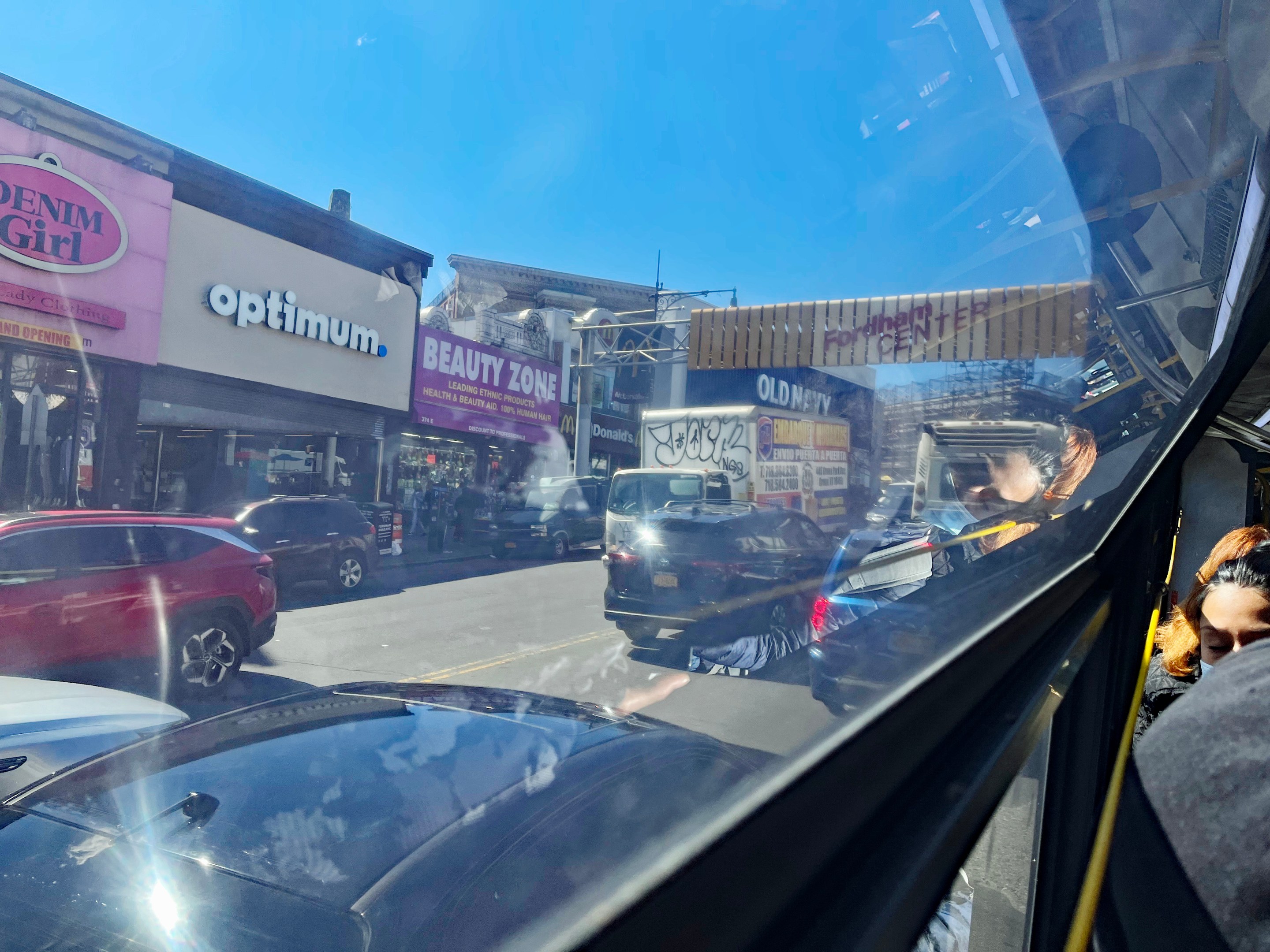Two out of three ain't bad.
The Department of Transportation last week revealed three scenarios to improve bus service along traffic-choked Fordham Road — and two of the three schemes call for a partial or full car-free busway design between Morris and Webster avenues, where bus speeds average less than 4 miles per hour.
DOT officials released the three proposals to the area's bus "Community Advisory Board" last Tuesday [PDF] after years discussion that has done nothing to improve service along traffic-clogged Fordham Road. Shortly after Mayor de Blasio took office in 2014, bus speeds and ridership on the Bx12 and Bx12 Select Bus peaked, with speeds dropping from an average of 9 miles per hour to 7.5 miles per hour during his eight years in office. Meanwhile, ridership dropped from close to 50,000 per day to just over 40,000 per day. With other bus lines that touch Fordham Road, the number of total riders per day is 85,000, according to DOT.
But bus speeds on the entire Bx12 route between Upper Manhattan and Co-op City — the busiest route in the borough — average speed of 5.4 miles per hour during peak hours — 2.5 miles per hour below the city average. Back before he was DOT Commissioner, then-Council Member Ydanis Rodriguez saw Fordham Road a critical transportation corridor linking his Upper Manhattan district to the Bronx — especially critical because 62 percent of households on corridor have no access to a car and 71 percent of residents commute on public transit, walking or biking.
And in street surveys conducted in July, 2019, 86 percent of visitors to businesses on Fordham Road told DOT that they arriving by walking, bus, or train — a finding that suggests that the agency's focus should be on bus riders, not car drivers, though local businesses told DOT they worry about their minority of customers who drive.
Each of the three solutions — the fruit of the latest round of workshops that began in June, 2019 — aims to improve bus service, but differ in approach:
Alternative A
Under this scenario, DOT would add painted bus lanes in areas where they don't currently exist:

Riders will certainly appreciate that the "upgrade" calls for the conversion of existing curbside bus lanes — which are often filled with cars — into offset lanes, which is an effort to keep parked cars out of the bus lane (though double-parked cars would still block the lane).
In this scenario, the agency also punted on what it would do on the University Heights Bridge, where bus speeds are "some of the slowest [on] the Bx12-SBS route," according to the DOT.
"Offset or curbside bus lanes will be explored on 207th St, from 10th Avenue and through the University Heights Bridge," the agency said.
Alternative B
In this scenario, eastbound bus riders get a car-free busway between Morris and Webster avenues, where bus speeds are among the slowest:
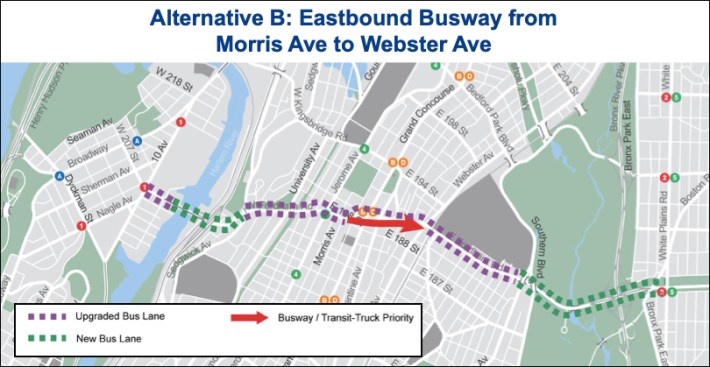
Under the "busway" scheme, though traffic, except for trucks and buses, is required to exit the route by making the first available right turn. (The rest of the route would get the same treatments proposed from Alternative A.)
That busway segment would be less than half of a mile — roughly similar to the bus priority zone on West 181st Street between Broadway and Amsterdam Avenue in Manhattan, which has shown success in increasing bus speeds since it was implemented last year.
But this alternative only offers eastbound bus riders the benefits of having cars mostly out of the way of their crowded buses. And, according to the DOT's own report, eastbound bus speeds tend to be 50 percent faster than westbound speeds through that congested corridor. Which brings us to...
Alternative C
In what is likely to be the most exciting plan from the perspective of transit advocates, the busway between Morris and Webster avenues would be in both directions:
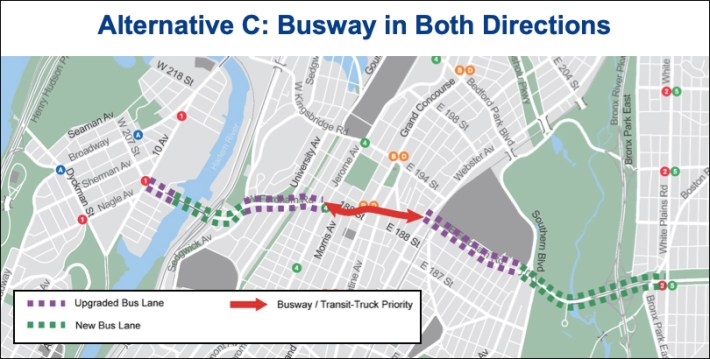
As expected, this scenario drew immediate support from activists.
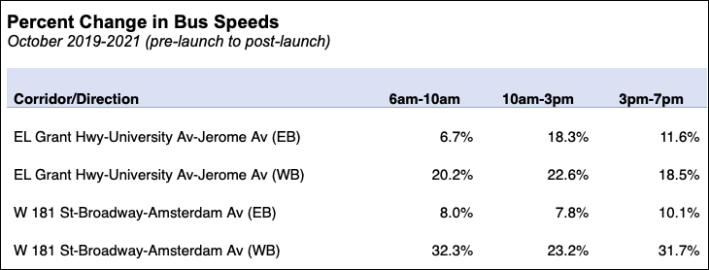
"Fordham Road is the main transit artery across the Bronx and should be a busway all day, every day," said Danny Pearlstein of Riders Alliance. "Alternative C would give riders the biggest speed boost. Besides that, DOT should also make big improvements to West 207th Street, which is currently a parking lot at the west end of the Bx12 SBS route."
Transportation Alternatives, which has long pushed for improvements on Fordham Road, was also pushing for Alternative C, especially how much better car-free space has proven for buses (see chart, above, of bus speed improvements no 181st Street and on the E.L. Grant Highway in the Bronx.
"The busiest bus routes in the Bronx need protected bus lanes, and the five routes along Fordham Road ... should not be crawling along in traffic,” said Juan Restrepo, the group's senior organizer. “Polling shows nearly nine in 10 people support improving the existing bus lanes, including 72 percent of non-bus riders. Reclaiming space from cars to build car-free busways, upgrade existing bus lanes, and improve service for tens of thousands of riders should be a priority as the city plans investments in Fordham Road.”
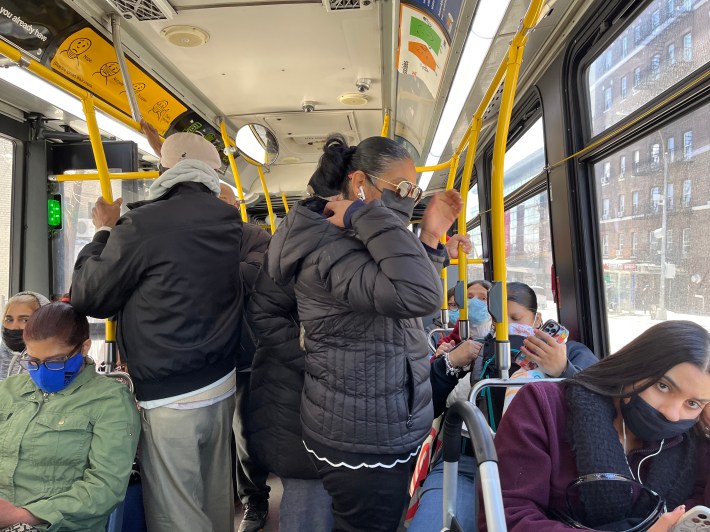
Lucia Deng, a Bronx transportation activist popular on Twitter as @luciadlite, said Alternative C "would be great in calming the space and making it a more attractive destination for the vast majority of folks who shop there."
Given the huge majority of people who arrive at Fordham Road businesses via transit, "it follows that changes making Fordham Road easier/quicker to get to by bus ... would have a significantly positive impact on the [business] community," she added. "Fordham Road is currently a very dangerous corridor for everyone, so deterring more private car traffic benefits all."
She called Alternative A "a mistake" because "buses (and bus lanes) are constantly being blocked by double-parked cars along stretches of that corridor."
"Accommodating parking will just lead to more illegal/double parking and congestion," she said.
Other experts pointed out that improving bus service for 85,000 people a day is a crucial equity issue for a city where a disproportionate number of Black residents rely on transit compared to White residents. And in the Census tracks that touch on the West Fordham Road portion of the corridor, nearly 80 percent of residents commute to work via bus or subway. In that same zone, 90 percent of the residents are Black or Latinx. And the median income is $32,000 per year, roughly half the city median income.
The existence of a proposal — well, three proposals — is the first step forward since January, 2021, when the DOT made its first presentation to the Community Advisory Board and said it “does not have a proposed design for the corridor” and would wait until that panel of elected officials, community groups and the local community boards offered sufficient input.
At the time, Streetsblog reported that judging by past timelines, that input process could take "another year before the Bronx’s long-suffering bus riders get relief." That timeline has turned out to be optimistic. At the March 15 meeting, the DOT said its timeline would end with "estimated implementation" in "mid-fall, 2022."
The problem with getting input from a "community advisory board" is that transit laypeople often send conflicting signals. In June, 2021, for example, this Fordham Road CAB told the DOT that it wanted a little bit of everything, including "physical barriers for bus lanes," "offset bus lanes to allow for parking along curb" and a "busway option for congested areas."
From now through the summer, DOT says it will study the traffic implications of all three scenarios and return in "early fall" with study results and "refined designs."
